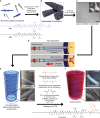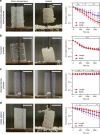Covalent-supramolecular hybrid polymers as muscle-inspired anisotropic actuators
- PMID: 29921928
- PMCID: PMC6008453
- DOI: 10.1038/s41467-018-04800-w
Covalent-supramolecular hybrid polymers as muscle-inspired anisotropic actuators
Abstract
Skeletal muscle provides inspiration on how to achieve reversible, macroscopic, anisotropic motion in soft materials. Here we report on the bottom-up design of macroscopic tubes that exhibit anisotropic actuation driven by a thermal stimulus. The tube is built from a hydrogel in which extremely long supramolecular nanofibers are aligned using weak shear forces, followed by radial growth of thermoresponsive polymers from their surfaces. The hierarchically ordered tube exhibits reversible anisotropic actuation with changes in temperature, with much greater contraction perpendicular to the direction of nanofiber alignment. We identify two critical factors for the anisotropic actuation, macroscopic alignment of the supramolecular scaffold and its covalent bonding to polymer chains. Using finite element analysis and molecular calculations, we conclude polymer chain confinement and mechanical reinforcement by rigid supramolecular nanofibers are responsible for the anisotropic actuation. The work reported suggests strategies to create soft active matter with molecularly encoded capacity to perform complex tasks.
Conflict of interest statement
The authors declare no competing interests.
Figures






References
-
- Peters SE. Structure and function in vertebrate skeletal muscle. Am. Zool. 1989;29:221–234. doi: 10.1093/icb/29.1.221. - DOI
-
- Hirokawa Y, Tanaka T. Volume phase transition in a nonionic gel. J. Chem. Phys. 1984;81:6379–6380. doi: 10.1063/1.447548. - DOI
-
- Tanaka T, et al. Phase transitions in ionic gels. Phys. Rev. Lett. 1980;45:1636–1639. doi: 10.1103/PhysRevLett.45.1636. - DOI
Publication types
MeSH terms
Substances
Grants and funding
LinkOut - more resources
Full Text Sources
Other Literature Sources

